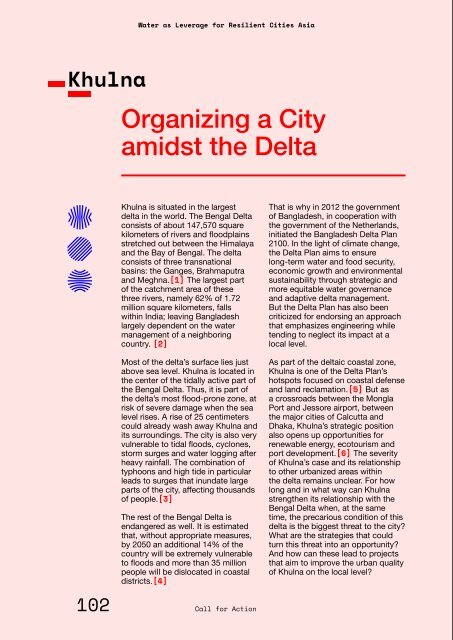Water as Leverage- Setting the scene for a call for action
- No tags were found...
You also want an ePaper? Increase the reach of your titles
YUMPU automatically turns print PDFs into web optimized ePapers that Google loves.
<strong>Water</strong> <strong>as</strong> <strong>Leverage</strong> <strong>for</strong> Resilient Cities Asia<br />
Khulna<br />
Organizing a City<br />
amidst <strong>the</strong> Delta<br />
[1]<br />
Ganges<br />
INDIA<br />
Brahmaputra<br />
BANGLADESH<br />
[2]<br />
INDIA<br />
BANGLADESH<br />
Khulna is situated in <strong>the</strong> largest<br />
delta in <strong>the</strong> world. The Bengal Delta<br />
consists of about 147,570 square<br />
kilometers of rivers and floodplains<br />
stretched out between <strong>the</strong> Himalaya<br />
and <strong>the</strong> Bay of Bengal. The delta<br />
consists of three transnational<br />
b<strong>as</strong>ins: <strong>the</strong> Ganges, Brahmaputra<br />
and Meghna.[1] The largest part<br />
of <strong>the</strong> catchment area of <strong>the</strong>se<br />
three rivers, namely 62% of 1.72<br />
million square kilometers, falls<br />
within India; leaving Bangladesh<br />
largely dependent on <strong>the</strong> water<br />
management of a neighboring<br />
country. [2]<br />
That is why in 2012 <strong>the</strong> government<br />
of Bangladesh, in cooperation with<br />
<strong>the</strong> government of <strong>the</strong> Ne<strong>the</strong>rlands,<br />
initiated <strong>the</strong> Bangladesh Delta Plan<br />
2100. In <strong>the</strong> light of climate change,<br />
<strong>the</strong> Delta Plan aims to ensure<br />
long-term water and food security,<br />
economic growth and environmental<br />
sustainability through strategic and<br />
more equitable water governance<br />
and adaptive delta management.<br />
But <strong>the</strong> Delta Plan h<strong>as</strong> also been<br />
criticized <strong>for</strong> endorsing an approach<br />
that emph<strong>as</strong>izes engineering while<br />
tending to neglect its impact at a<br />
local level.<br />
Jessore<br />
Khulna<br />
[4]<br />
[3]<br />
[6]<br />
Dhaka<br />
Bangladesh<br />
Delta Plan<br />
Co<strong>as</strong>tal Zone<br />
[5]<br />
Meghna<br />
Most of <strong>the</strong> delta’s surface lies just<br />
above sea level. Khulna is located in<br />
<strong>the</strong> center of <strong>the</strong> tidally active part of<br />
<strong>the</strong> Bengal Delta. Thus, it is part of<br />
<strong>the</strong> delta’s most flood-prone zone, at<br />
risk of severe damage when <strong>the</strong> sea<br />
level rises. A rise of 25 centimeters<br />
could already w<strong>as</strong>h away Khulna and<br />
its surroundings. The city is also very<br />
vulnerable to tidal floods, cyclones,<br />
storm surges and water logging after<br />
heavy rainfall. The combination of<br />
typhoons and high tide in particular<br />
leads to surges that inundate large<br />
parts of <strong>the</strong> city, affecting thousands<br />
of people.[3]<br />
The rest of <strong>the</strong> Bengal Delta is<br />
endangered <strong>as</strong> well. It is estimated<br />
that, without appropriate me<strong>as</strong>ures,<br />
by 2050 an additional 14% of <strong>the</strong><br />
country will be extremely vulnerable<br />
to floods and more than 35 million<br />
people will be dislocated in co<strong>as</strong>tal<br />
districts.[4]<br />
As part of <strong>the</strong> deltaic co<strong>as</strong>tal zone,<br />
Khulna is one of <strong>the</strong> Delta Plan’s<br />
hotspots focused on co<strong>as</strong>tal defense<br />
and land reclamation.[5] But <strong>as</strong><br />
a crossroads between <strong>the</strong> Mongla<br />
Port and Jessore airport, between<br />
<strong>the</strong> major cities of Calcutta and<br />
Dhaka, Khulna’s strategic position<br />
also opens up opportunities <strong>for</strong><br />
renewable energy, ecotourism and<br />
port development.[6] The severity<br />
of Khulna’s c<strong>as</strong>e and its relationship<br />
to o<strong>the</strong>r urbanized are<strong>as</strong> within<br />
<strong>the</strong> delta remains unclear. For how<br />
long and in what way can Khulna<br />
streng<strong>the</strong>n its relationship with <strong>the</strong><br />
Bengal Delta when, at <strong>the</strong> same<br />
time, <strong>the</strong> precarious condition of this<br />
delta is <strong>the</strong> biggest threat to <strong>the</strong> city?<br />
What are <strong>the</strong> strategies that could<br />
turn this threat into an opportunity?<br />
And how can <strong>the</strong>se lead to projects<br />
that aim to improve <strong>the</strong> urban quality<br />
of Khulna on <strong>the</strong> local level?<br />
102 Call <strong>for</strong> Action<br />
PART 1 / From Global <strong>Water</strong> Issues to a Call <strong>for</strong> Action<br />
Calcutta<br />
Mongla<br />
103


















